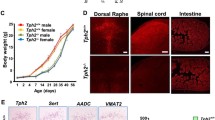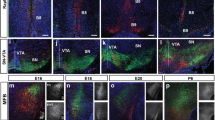Abstract
The serotonin 5-hydroxytryptamine (5-HT) neurotransmitter system contributes to various physiological and pathological conditions. 5-HT is the first neurotransmitter for which a developmental role was suspected. Tryptophan hydroxylase (TPH) catalyzes the rate-limiting reaction in the biosynthesis of 5-HT. Both TPH1 and TPH2 have tryptophan hydroxylating activity. TPH2 is abundant in the brain, whereas TPH1 is mainly expressed in the pineal gland and the periphery. However, TPH1 was found to be expressed predominantly during the late developmental stage in the brain. Recent advances have shed light on the kinetic properties of each TPH isoform. TPH1 showed greater affinity for tryptophan and stronger enzymic activity than TPH2 under conditions reflecting those in the developing brain stem. Transient alterations in 5-HT homeostasis during development modify the fine wiring of brain connections and cause permanent changes to adult behavior. An increasing body of evidence suggests the involvement of developmental brain disturbances in psychiatric disorders. These findings have revived a long-standing interest in the developmental role of 5-HT-related molecules. This article summarizes our understanding of the kinetics and possible neuronal functions of each TPH during development and in the adult.
Similar content being viewed by others
References
Kaufman S. and Fisher D. B. (1974) Pterin-dependent aromatic amino acid hydroxylases. In: Hayaishi O., ed., Molecular Mechanisms of Oxygen Activation, New York and London: Academic Press, pp. 285–369.
Hosoda S. and Glick D. (1965) Biosynthesis of 5-hydroxytryptophan and 5-hydroxytryptamine from tryptophan by neoplastic mouse mast cells. Biochim. Biophys. Acta. 111, 67–78.
Grahame S. D. (1967) The biosynthesis of 5-hydroxytryptamine in brain. Biochem. J. 105, 351–360.
Lovenberg W., Jequier E., and Sjoerdsma A. (1967) Tryptophan hydroxylation: measurement in pineal gland, brainstem, and carcinoid tumor. Science 155, 217–219.
Ichiyama A., Nakamura S., Nishizuka Y., and Hayaishi O. (1970) Enzymic studies on the biosynthesis of serotonin in mammalian brain. J. Biol. Chem. 245, 1699–1709.
Ichiyama A., Hasegawa H., Tohyama C., Dohmoto C., and Kataoka T. (1976) Some properties of bovine pineal tryptophan hydroxylase. Adv. Exp. Med. Bio. 74, 103–117.
Hosoda S. (1975) Further studies on tryptophan hydroxylase from neoplastic murine mast cells. Biochim. Biophys. Acta. 397, 58–68.
Nakata H. and Fujisawa H. (1982) Tryptophan 5-monooxygenase from mouse mastocytoma P815. A simple purification and general properties. Eur. J. Biochem. 124, 595–601.
Tong, J. H. and Kaufman S. (1975) Tryptoplan hydroxylase. Purification and some properties of the enzyme from rabbit hindbrain. J. Biol. Chem. 250, 4152–4158.
Nakata H. and Fujisawa H. (1982) Purification and properties of tryptophan 5-monooxygenase from rat brain-stem. Eur. J. Biochem. 122, 41–47.
Cash C. D., Vayer P., Mandel P., and Maitre M. (1985) Tryptophan 5-hydroxylase. Rapid purification from whole rat brain and production of a specific antiserum. Eur. J. Biochem. 149, 239–245.
Kuhn D. M., Meyer M. A., and Lovenberg W. (1980) Comparisons of tryptophan hydroxylase from a malignant murine mast cell tumor and rat mesencephalic tegmentum. Arch. Biochem. Biophys. 199, 355–361.
Hasegawa H., Yanagisawa M., Inoue F., Yanaihara N., and Ichiyama A. (1987) Demonstration of non-neural tryptophan 5-mono-oxygenase in mouse intestinal mucosa. Biochem. J. 248, 501–509.
Walther D. J., Peter J. U., Bashammakh S., et al. (2003) Synthesis of serotonin by a second tryptophan hydroxylase isoform. Science 299, 76.
Zhang X., Beaulieu J. M., Sotnikova T. D., Gainetdinov R. R., and Caron M. G. (2004) Tryptophan hydroxylase-2 controls brain serotonin synthesis. Science 305, 217.
Teraoka H., Russell C., Regan J., et al. (2004) Hedgehog and Fgf signaling pathways regulate the development of tphR-expressing serotonergic raphe neurons in zebrafish embryos. J. Neurobiol. 60, 275–288.
Coleman C. M. and Neckameyer W. S. (2005) Serotonin synthesis by two distinct enzymes in Drosophila melanogaster. Arch. Insect Biochem. Physiol. 59, 12–31.
McKinney J., Knappskog P. M., Pereira J., et al. (2004) Expression and purification of human tryptophan hydroxylase from Escherichia coli and Pichia pastoris.
Lucki I (1998) The spectrum of behaviors influenced by serotonin. Biol. Psychiatry 44, 151–162.
Lesch K. P. (2004) Gene-environment interaction and the genetics of depression. J. Psychiatry Neurosci. 29, 174–184.
Lesch K. P., Bengel D., Heils A., et al. (1996) Association of anxiety-related traits with a polymorphism in the serotonin transporter gene regulatory region. Science 274, 1527–1531.
Shih J. C., Chen K., and Ridd M. J. (1999) Monoamine oxidase: from genes to behavior. Annu. Rev. Neurosci. 22, 197–217.
Gainetdinov R. R. and Caron M. G. (2003) Monoamine transporters: From genes to behavior. Annu. Rev. Pharmacol. Toxicol. 43, 261–284.
Gaspar P., Cases O., and Maroteaux L. (2003) The developmental role of serotonin: news from mouse molecular genetics. Nat. Rev. Neurosci. 4, 1002–1012.
Côté F., Thevenot E., Fligny C., et al. (2003) Disruption of the nonneuronal tph1 gene demonstrates the importance of peripheral serotonin in cardiac function. Proc. Natl. Acad. Sci. U.S.A. 100, 13,525–13,530.
Nakamura K., Sugawara Y., and Sawabe K., et al. (2006) Late developmental stage-specific role of tryptophan hydroxylase 1 in brain serotonin levels. J. Neurosci. 26, 530–534.
Mann J. J., Malone K. M., Nielsen D. A., Goldman D., Erdos J., and Gelernter J. (1997) Possible association of a polymorphism of the tryptophan hydroxylase gene with suicidal behavior in depressed patients. Am. J. Psychiatry 154, 1451–1453.
Nielsen D. A., Virkkunen M., Lappalainen J., et al. (1998) A tryptophan hydroxylase gene marker for suicidality and alcoholism. Arch. Gen. Psychiatry 55, 593–602.
Rujescu D., Giegling I., Sato T., Hartmann A. M., and Moller H. J. (2003) Genetic variations in tryptophan hydroxylase in suicidal behavior: analysis and meta-analysis. Biol. Psychiatry 54, 465–473.
Bellivier F., Chaste P., and Malafosse A. (2004) Association between the TPH gene A218C polymorphism and suicidal behavior: a meta-analysis. Am. J. Med. Genet. B Neuropsychiatr. Genet. 124, 87–91.
Peters E. J., Slager S. L., McGrath P. J., Knowles J. A., and Hamilton S. P. (2004) Investigation of serotonin-related genes in antide-pressant response. Mol. Psychiatry 9, 879–889.
Ichiyama A., Hori S., Mashimo Y., Nukiwa T., and Makuuchi H. (1974) The activation of bovine pineal tryptophan 5-monooxygenase. FEBS Lett. 40, 88–91.
Ichiyama A., Hasegawa H., Tohyama C., Dohmoto C., and Kataoka T. (1976) Some properties of bovine pineal tryptophan hydroxylase. Adv. Exp. Med. Biol. 74, 103–117.
Inoue F., Hasegawa H., Yamada M., and Ichiyama A. (1987) The serotonin content and tryptophan 5-monooxygemase activity in the stomach of an athymic mouse and mast cell-deficient mouse. Biomed. Res. 8, 53–59.
Hasegawa H., Yanagisawa M., and Ichiyama A. (1983) Three discrete activity states of mastocy toma tryptophan 5-monooxygenase. In: Nozaki M., Yamamoto S., Ishimura Y., Coon M. J., Ernster L., and Estabrook R.W., eds., Oxygenases and Oxygen Metabolism, London, UK: Academic Press, pp. 296–304.
Yanagisawa M., Hasegawa H., Ichiyama A., Hosoda S., and Nakamura W. (1984) Comparison of serotonin-producing murine mastocytomas, P-815 and FMA3: Determination of tryptophan hydroxylase, aromatic L-amino acid decarboxylase, and cellular concentration of tryptophan, 5-hydroxytryptophan, 5-hydroxytryptamine and 5-hydroxyindoleacetic acid. Biomed. Res. 5, 19–28.
Hasegawa H. and Ichiyama A. (2005) Distinctive iron requirement of tryptophan 5-monooxygenase: TPH1 requires dissociable ferrous iron. Biochem. Biophys. Res. Commun. 338, 277–284.
Ehret M., Cash C. D., Hamon M., and Maitre M. (1989) Formal demonstration of the phosphorylation of rat brain tryptophan hydroxylase by Ca2+/calmodulin-dependent protein kinase. J. Neurochem. 52, 1886–1891.
Makita Y., Okuno S., and Fujisawa H. (1990) Involvement of activator protein in the activation of tryptophan hydroxylase by cAMP-dependent protein kinase. FEBS Lett. 268, 185–188.
Hasegawa H., Kojima M., Oguro K., and Nakanishi N. (1995) Rapid turnover of tryptophan hydroxylase in serotonin producing cells: demonstration of ATP-dependent proteolytic degradation. FEBS Lett. 368, 151–154.
Kojima M., Oguro K., Sawabe K., et al. (2000) Rapid turnover of tryptophan hydroxylase is driven by proteasomes in RBL2H3 cells, a serotonin producing mast cell line. J. Biochem. (Tokyo) 127, 121–127.
Iida Y., Sawabe K., Kojima M., Oguro K., Nakanishi N., and Hasegawa H. (2002) Proteasome-driven turnover of tryptophan hydroxylase is triggered by phosphorylation in RBL2H3 cells, a serotonin producing mast cell line. Eur. J. Biochem. 269, 4780–4788.
McKinney J., Knappskog P. M., and Haavik J. (2005) Different properties of the central and peripheral forms of human tryptophan hydroxylase. J. Neurochem. 92, 311–320.
Abbar M., Courtet P., Bellivier F., et al. (2001). Suicide attempts and the tryptophan hydroxylase gene. Mol. Psychiatry 6, 268–273.
Rujescu D., Giegling I., Sato T., Hartmann A. M., and Moller H. J. (2003) Genetic variations in tryptophan hydroxylase in suicidal behavior: analysis and meta-analysis. Biol. Psychiatry 54, 465–473.
Bellivier F., Leboyer M., Courtet P., et al. (1998) Association between the tryptophan hydroxylase gene and manic-depressive illness. Arch. Gen. Psychiatry 55, 33–37.
Furlong R. A., Ho L., Rubinsztein J. S., Walsh C., Paykel E. S., and Rubinsztein D. C. (1998) No association of the tryptophan hydroxylase gene with bipolar affective disorder, unipolar affective disorder, or suicidal behaviour in major affective disorder. Am. J. Med. Genet. 81, 245–247.
Kirov G., Owen M. J., Jones I., McCandless F., and Craddock N. (1999) Tryptophan hydroxylase gene and manic-depressive illness. Arch. Gen. Psychiatry 56, 98,99.
McQuillin A., Lawrence J., Kalsi G., Chen A., Gurling H., and Curtis D. (1999) No allelic association between bipolar affective disorder and the tryptophan hydroxylase gene. Arch. Gen. Psychiatry 56, 99–101
Tsai S. J., Hong C. J., and Wang Y. C. (1999) Tryptophan hydroxylase gene polymorphism (A218C) and suicidal behaviors. Neuroreport 10, 3773–3775.
Courtet P., Jollant F., Castelnau D., Buresi C., and Malafosse A. (2005) Suicidal behavior: relationship between phenotype and serotonergic genotype. Am. J. Med. Genel. C Semin. Med. Genet. 133, 25–33.
Cervo L., Canetta A., Calcagno E., et al. (2005) Genotype-dependent activity of tryptophan hydroxylase-2 determines the response to citalopram in a mouse model of depression. J. Neurosci. 25, 8165–8172.
Crowley J. J., Blendy J. A., and Lucki I. (2005) Strain-dependent antidepressant-like effects of citalopram in the mouse tail suspension test. Psychopharmacology (Berl) 183, 257–264.
Lipton S. A. and Kater S. B. (1989) Neurotransmitter regulation of neuronal outgrowth, plasticity and survival. Trends Neurosci. 12, 265–270.
Lauder J. M. (1993) Neurotransmitters as growth regulatory signals: role of receptors and second messengers. Trends Neurosci. 16, 233–239.
Levitt P., Harvey J. A., Friedman E., Simansky K., and Murphy E. H. (1997) New evidence for neurotransmitter influences on brain development. Trends Neurosci. 20, 269–274.
Azmitia E. C. (2001) Modern view on an ancient chemical: serotonin effects on proliferation, maturation, and apoptosis. Brain Res. Bull. 56, 414–424.
Vitalis T. and Parnavelas J. (2003) Serotonin and cortical development. Exp. Neurol. 25, 245–256.
Hendricks T. J., Francis N., Fyodorov D. J. and Deneris E. S. (1999) The ETS domain factor Pet-1 is an early and precise marker of central 5-HT neurons and interacts with a conserved element in serotonergic genes. J. Neurosci. 19, 10,348–10,356.
Pfaar H., von Holst A., Vogt Weisenhorn D. M., Brodski C., Guimera J., and Wurst W. (2002) mPet-1, a mouse ETS-domain transcription factor, is expressed in central serotonergic neurons. Dev. Genes Evol. 212, 43–46.
De Vitry F., Hamon M., Catelon J., Dubois M., and Thibault J. (1986) Serotonin initiates and autoamplifies its own synthesis during mouse central nervous system development. Proc. Natl Acad. Sci. USA 83, 8629–8633.
Galter D. and Unsicker K. (2000) Sequential activation of the 5-HT1A serotonin receptor and TrkB induces the serotonergic neuronal phenotype. Am. J. Anat. 15, 446–455.
Whitaker-Azmitia P. M. and Azmitia E. C. (1989) Stimulation of astroglial serotonin receptors produces culture media which regulates growth of serotonergic neurons. Brain Res. 497, 80–85.
Salichon N., Gaspar P., Upton A. L., et al. (2001) Excessive activation of serotonin (5-HT) 1B receptors disrupts the formation of sensory maps in monoamine oxidase and 5-HT transporter knock-out mice. J. Neurosci. 21, 884–896.
Luna B. and Sweeney J. A. (2001) Studies of brain and cognitive maturation through childhood and adolescence: a strategy for testing neurodevelopmental hypotheses. Schizophr. Bull. 27, 443–455.
Author information
Authors and Affiliations
Corresponding author
Rights and permissions
About this article
Cite this article
Nakamura, K., Hasegawa, H. Developmental role of tryptophan hydroxylase in the nervous system. Mol Neurobiol 35, 45–53 (2007). https://doi.org/10.1007/BF02700623
Received:
Accepted:
Issue Date:
DOI: https://doi.org/10.1007/BF02700623




